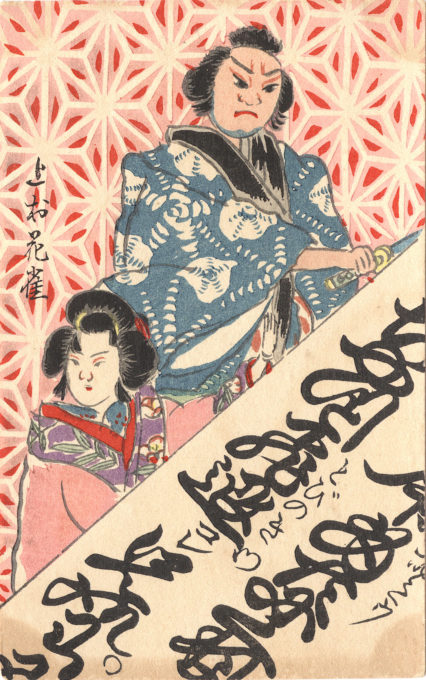See also:
Kabuki theater & actors, c. 1910.
The Kawakami Theater performing “Okan” at Meiji-za, Tokyo, c. 1905.
“Kabuki, the popular theatre, and Nyngyo Shibai, or the doll-theatre [also known as bunraku]. were the two chief amusements of the people during the long Tokugawa period when the Shogun ruled in Yedo and Japan was shut off from foreign intercourse.
“The exact date when the minstrel, the music of the samisen, and the nyngyo began their remarkable collaboration in Japan is not known. This combination of ballad sung and recited by minstrels to the accompaniment of the samisen, while the dolls moved to the rhythm of the instrument and interpreted the words and actions of the ballad, was called joruri, because the first ballad to be sung concerned the adventures of that hero of so many romances, Yoshitsune, and the fair princess Joruri.
“[But] to Menukiya Chosaburo is attributed the distinction of founding the doll-theatre. He obtained the services of a man in Nishinomiya, a village near Osaka, who knew how to make dolls, and started to move them so that they expressed the emotions of the different characters in his plays.
“He first performed in Kyoto, and had the honour of being summoned before the Emperor who wished to see his performances. Such was the dignity of the early puppets, Kyoto continued to be the centre of the dolls’ activities, and their vogue spread to the surrounding towns and they were well received in Osaka.
“… Lovers of Kabuki do not like to acknowledge the debt it owes to the doll-theatre, but it was and is very great. Kabuki actors imitated the movements of the dolls, and reproduced the exact colours and designs of the dolls’ costumes. Sometimes famous actors were songs of nyngyo tsukai, and young actors went to nyngyo performances to learn.
“Indeed, the dolls and their plays were the real foundation of the modern Japanese stage, and even to-day the plays written for the inanimate figures are repeated over and over again, for after the thorough test of time their vitality is still undimmed.
“As fast as the doll theatre artists evolved new plays, scenery, or costumes, they were quickly seized upon by Kabuki. The public came at last to be more interested in the real actors than in the figures of wood and brocade, and interest in the dolls slowly but surely began to wane. The doll-theatre had been the centre of talent, but it was a misfortune for the dolls when those who had been accustomed to collaborate for their sake began to drift apart.
“In 1757 the doll theatre was at its height. After this it steadily declined. The vogue for the dolls had continued over a period of ninety years.
“… Many lovers of the nyngyo mournfully shake their heads, and say it is a pity the doll art is no longer appreciated and that sooner or later it must disappear. These pessimists are not aware that the art of the doll is beginning to assert itself in Western countries, and that the despised puppet is coming into its own again after centuries of neglect. The Japanese would throw overboard a perfected art that is only just [beginning to be expressed] in the Occident.”
– Nyngyo: Doll Players in Doll Dramas: Japan’s Unique Theatre Art, by Zoe Kincaid, The Far East, December 1920


